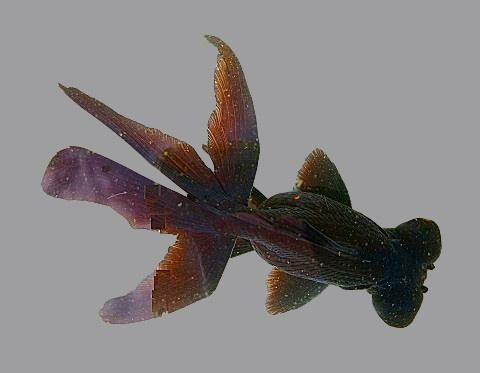| Back to Back Issues Page |
 |
|
The Goldfish Gazette, Issue #142 Signs of stunted Growth October 31, 2025 |
Goldfish Care TipsA Free Monthly Resource For Goldfish Enthusiasts In This Issue Signs of stunting are evident when fish fail to grow in body length, but their fins continue to develop. Signs of Stunted Growth Stunting is more noticeable with fancy varieties because, as they fail to grow, their attributes, such as long tail fins or telescopic eyes, continue to grow out of proportion to their body size.
Stunting is more noticeable with fancy varieties because, as they fail to grow, their attributes, such as long tail fins or telescopic eyes, continue to grow out of proportion to their body size.
Another strong indicator of stunting is a twisted or bent tail, or abnormal development of the dorsal or pectoral fins. This is more evident in longer finned varieties. The fish shown above is nearly four years old, only 60mm (2.36 inches) in body length and clearly exhibits stunted growth, as evidenced by its long fins and large eyes. Causes of StuntingThe main causes of stunting are:
FeedingFeeding too little food is an obvious reason, and more common than you would think, especially as the instructions on most food packets instruct the owner to feed no more than the fish can consume in 2-3 minutes.This is fine if you are feeding multiple times daily, but at a 2% body weight per day feeding rate, spread over three feeds, my fish take 8 minutes at each feeding to clean up all the food. Goldfish should be fed between 0.5% and 3% of their body weight daily (during the warmer months). Feeding 0.5% of their body weight daily will mean the fish will grow very slowly, if at all, but they won't be starving. This level of feeding is used to stop fish from outgrowing their tank, but it can lead to excessive feeding competition. The smaller fish in the aquarium will receive less and less food, leading to stunted growth. If you are feeding 1-3% of their body weight and your fish aren't growing, feeding isn't the problem. ParasitesParasites are a real problem for smaller fish (body length 50mm (2 inches) or less).Flukes, both gill and body, will stop any growth of fry and juvenile fish, if they don't kill the fish outright. Infestations must be dealt with quickly, otherwise, young fish rarely seem to thrive after a prolonged attack. Physical deformitiesThe most common physical deformity causing stunting is a mouth deformity. It's not the deformity itself that causes stunting, but rather the fish's inability to compete successfully for food.These fish can grow quite successfully if feeding is tailored to their needs. Water conditionsIf it isn’t parasites, and your feeding regime is adequate, then the only other parameter that affects growth significantly is water conditions.I’m not referring to water quality, as I am assuming your water is filtered with ammonia at zero, and nitrates are below 40 ppm (yes, I know this figure is not achievable in some parts of the world, but that is the target figure). Do you know what your water source's GH (general hardness) and KH (carbonate hardness) values are? If you live in an area with very soft water as I do, be aware that it lacks the essential elements that Goldfish need to grow. Goldfish are hard water fish, requiring a GH of around dGH 11 (300 ppm), and a KH of around dKH 8 (140 ppm). Combined GH/KH Test kits are available from API and are simple to use. Reversing StuntingIs it possible to reverse stunted growth?From my early testing, absolutely. I suspect the younger the fish, the better the turnaround. Using 17-month-old Moors that refused to grow larger than 64mm (2.50 inches), when given optimal growing conditions, they grew 16mm in 67 days. That is a 25% increase in body length and a doubling of their body weight. I will be conducting testing on much older fish, such as the Moor in the image, to see if similar results can be achieved. Comments? Ideas? Feedback? I'd love to hear from you. Just reply to this e-zine and tell me what you think, or what topics you want to be covered. www.facebook.com/aboutgoldfish |
| Back to Back Issues Page |